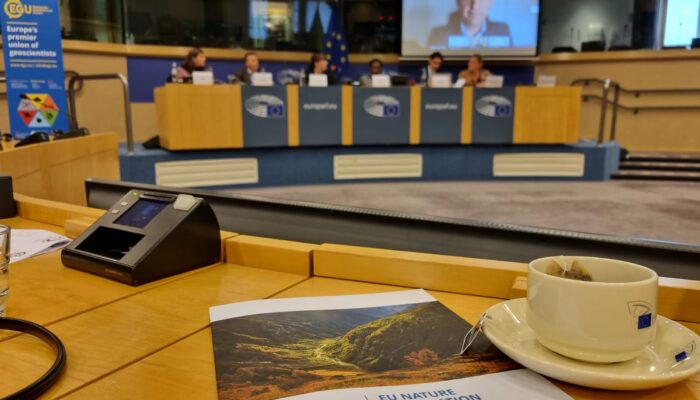
When working on legislation, policymakers often require scientific evidence or expertise to support their decision-making. Scientific information can help policymakers to identify any unintended consequences of a policy decision and access solutions that they may not have otherwise considered.
In many cases, the information that researchers give to policymakers is a summary of a single study that they or their colleagues have written. However, if you want to have a policy impact, it’s more effective to provide policymakers with a knowledge synthesis – a summary that answers a policy question using evidence from multiple studies and from a variety of scientific disciplines. A knowledge synthesis provides policymakers with a broader and more comprehensive overview of the policy issue or question. Having multiple scientific sources also helps to ensure the information is robust, increases the credibility of the information provided, and illuminates areas of consensus.
Despite having clear advantages, creating a knowledge synthesis that is relevant, timely, and useful for policymakers can be challenging! Below are steps that you can take to help ensure that you knowledge synthesis is seen and used by policymakers.
1. Understand the political landscape and needs of policymakers
Getting to know the political landscape will enable you to understand key policy questions around your selected legislation or policy area and why they are being asked. It will also help you to identify which political institutions may find your synthesis useful, tailor your evidence to policy needs, and ensure that you disseminate your knowledge synthesis at the right time. You can gain a better understanding of the political landscape by attending policy-related events (both in person and online) and meeting others who are working on the same or similar topics.
2. Frame the policy question that you’re aiming to answer
Before you start collecting information, it’s vital that you find a specific policy question, topic or area that you want to address. Policymakers have limited time and resources and will be unlikely to read anything unsolicited that you send them that is longer than a few pages. You should aim to keep your knowledge synthesis as short and as focused as possible. Providing relevant, contextualized, and accurate information on one or two specific issues, is likely to have a greater impact than trying to provide information on a range of more general topics.
If a policymaker has solicited you to answer a specific policy question, make sure that there aren’t being assumptions being made and that the question can be answered. Don’t be afraid to discuss the question with the policy team that you’re working with to narrow or adjust the scope if needed.
3. Identify the range of knowledge & scientific disciplines needed
Including a variety of scientific disciplines and sources of knowledge is key when creating a knowledge synthesis. Different experts are likely to address the policy question or issue from a different perspective and may include aspects that you would not have thought of. Working and listening to a range of experts will strengthen your synthesis and its credibility.
4. Build your network
To obtain a variety of perspectives needed for a knowledge synthesis, you may have to broaden your network to ensure that it includes experts outside of your scientific discipline. This step can be time-consuming but also fulfilling and supportive of other areas of your work. Ideally, you should start expanding your network before starting a knowledge synthesis but if not, then there’s no time like the present!
5. Collect the Evidence
Now that you’ve built a network and have some support in understanding the range of evidence that should be included in your knowledge synthesis, it’s time to start collecting the information! Using your network to help you to collect this information is a great idea as they may be able to share key research and studies within their field. Experts from different disciplines should also be used to ensure the information collected is accurate, reliable, and based on the most robust and applicable evidence.
6. Summarise and integrate the information collected
When integrating the information that you’ve collected, it’s important that it has a coherent narrative or framework. The message(s), areas of agreement and disagreement, and potential solutions that you’re aiming to convey to the policymaker should be clear. This may, for example, involve outlining the implications of the evidence for particular legislative decision or providing a range of policy options that the policymaker may consider.
7. Summarise the summary
Once you’ve integrated and summerised the information collected, it’s time to make a summary of the summary – an Executive Summary that provides the policymaker reading it with the key messages and a reason to continue reading. You should be able to use this Executive Summary as an elevator pitch and to verbally explain your knowledge synthesis to non-experts.
8. Eliminate unnecessary evidence and information
No matter how selective you were when curating the evidence to use in your synthesis, once you get to this stage, there’s always going to be an excess of information that isn’t absolutely essential. Even if the document you produce is short, policymakers are unlikely to read it all – and you want to make sure that everything that they do read is useful to them.
Going through with a critical eye and ensuring each section is relevant and contextualised to the policy question or issue may help you identify parts to cut. You may also like to turn to your network for advice on what sections, sentence, or words should be removed as it can be hard to stay objective when you’re cutting out text that you spent weeks writing and perfecting.
9. Create an appealing layout and design
The final step before publishing and disseminating your knowledge synthesis is making sure that it looks appealing and is easy to read. While we shouldn’t judge a book by it’s cover, having an attractive and professional looking document can add to its credibility and make a policymaker more likely to take a look inside. Furthermore, an appealing design that presents your information in a way that is accessible is likely to increase the amount of the document that is read.
10. Disseminate your knowledge synthesis
The best knowledge synthesis in the world won’t make an impact if it isn’t shared with the people who need to see it. Selecting your target audience and who is likely to use the information that you are synthesising is something that should be done during step one – while you’re learning about the political landscape – but you still have to make sure that the document ends up in their hands.
The most straight forward way of sharing your knowledge synthesis is by emailing it to the relevant policymakers (and their assistants) with a short summary in the email text. It’s also a good idea to invite them to contact you if they have any further questions. You can also publish the knowledge synthesis online and share it with your wider network in the hopes that someone will pass it onto a relevant contact.
Hosting an event to launch your knowledge synthesis and discuss the policy question or challenge more broadly is more effort but can be very effective. If you decide to host an event you can invite some of your target policymakers or stakeholders as speakers. This will ensure that they read the synthesis and give them an opportunity to meet you and ideally build trust for further collaboration.
If you have experiences synthesising knowledge for policymakers, please feel free to share them (and your own tips) in the comment section below!






